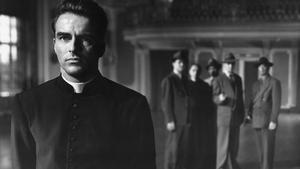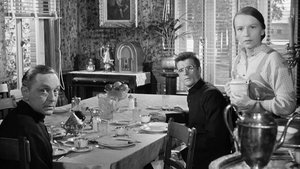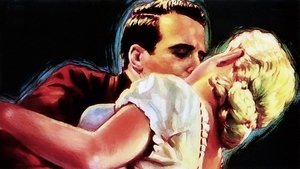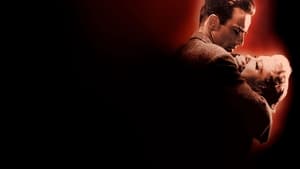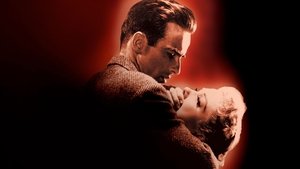Contact: info@alwanfilm.com
Video Sources 0 Views
- Watch trailer
- I Confess


Synopsis
Table of Contents
ToggleReview: I Confess 1953 Colorized – Analyzing the Impact of Early Colorization

Introduction
Released in 1953, I Confess stands as a compelling testament to the masterful storytelling of Alfred Hitchcock. Known for his deft ability to weave suspense and drama, Hitchcock delivers a gripping narrative that explores themes of guilt, faith, and morality. In this review, we’ll delve into how the early colorization of I Confess affects the viewer’s experience of this classic Hitchcockian thriller.
Check The Full Colorized Movies List
Check Our Colorized Movies Trailer Channel
Understanding I Confess 1953 Colorized: Director, Cast, and Genre
Directed by the legendary Alfred Hitchcock, I Confess boasts a stellar cast led by Montgomery Clift as Father Michael Logan, a conflicted Catholic priest, and Anne Baxter as Ruth Grandfort, a woman caught in a web of secrets and lies. Set against the backdrop of Quebec City, the film blends elements of mystery, suspense, and courtroom drama to create a riveting tale of intrigue and deception.
Exploring the World of I Confess 1953 Colorized: Plot and Characters
I Confess follows the plight of Father Michael Logan, who becomes the prime suspect in a murder investigation after hearing the confession of the true culprit. As he grapples with his moral duty to uphold the sanctity of the confessional and his desire to clear his name, Father Logan finds himself drawn into a web of deceit that threatens to unravel his life and faith. With its taut pacing and Hitchcock’s signature suspenseful storytelling, I Confess keeps audiences on the edge of their seats from start to finish.
The Art of Film Colorization
Film colorization has been a subject of much debate in the film industry. While some argue that it breathes new life into classic films and makes them more accessible to modern audiences, others contend that it compromises the artistic integrity of the original work. Regardless of one’s stance on the issue, early colorization techniques offer a fascinating glimpse into the evolving landscape of film preservation and restoration.
Early Colored Films: A Brief History
The history of early colored films is a rich tapestry of experimentation and innovation. From hand-painted frames to pioneering color processes like Technicolor, filmmakers have long sought to capture the vibrancy of the world on celluloid. While early color techniques may seem primitive by today’s standards, they laid the groundwork for the dazzling visual effects and digital wizardry that define modern cinema.
I Confess 1953 and Its Early Colored Version
The decision to release I Confess in a colorized format was met with both anticipation and skepticism. While some saw it as an opportunity to breathe new life into a classic Hitchcock thriller, others worried that it would detract from the film’s moody atmosphere and noir-inspired aesthetic. Ultimately, whether one prefers the original black and white version or the colorized edition is a matter of personal preference. However, the colorized version offers a fresh perspective on I Confess, allowing audiences to see familiar scenes in a new light and perhaps discover new depths to the film’s visual and emotional impact.
The Debate Over Film Colorization
The debate over film colorization continues to rage on, with proponents praising its ability to make classic films more accessible to modern audiences and opponents arguing that it compromises the artistic integrity of the original work. While there may never be a clear consensus on the issue, one thing is certain: early colorization techniques offer a fascinating glimpse into the evolving landscape of film preservation and restoration.
Examining I Confess 1953 as an Early Colored Film
Viewing I Confess in its early colorized iteration offers a unique viewing experience. While the colorization adds a layer of visual richness to the film, some may argue that it detracts from the moody atmosphere and noir-inspired aesthetic of the original black and white version. However, others may appreciate the opportunity to see familiar scenes in a new light, with vibrant colors enhancing the film’s visual and emotional impact. Ultimately, whether one prefers the original black and white version or the colorized edition is a matter of personal preference.
Influence and Legacy: I Confess 1953 Colorized’s Impact on Cinema
I Confess may not be as well-known as some of Hitchcock’s other works, but its impact on the cinematic landscape is undeniable. With its compelling narrative, standout performances, and timeless themes, the film has earned its place in the annals of cinematic history, inspiring filmmakers and captivating audiences for generations to come.
Director’s Cinematic Legacy: Beyond I Confess 1953 Colorized
Alfred Hitchcock’s directorial legacy extends far beyond I Confess. Throughout his career, he pushed the boundaries of conventional filmmaking, crafting a body of work that continues to influence filmmakers to this day. His masterful storytelling and keen eye for detail have left an indelible mark on the world of cinema, cementing his status as one of the greatest filmmakers of all time.
Themes Explored in I Confess 1953 Colorized
At its core, I Confess explores themes of guilt, faith, and morality. Through its compelling narrative and richly drawn characters, the film offers a thought-provoking meditation on the complexities of the human condition and the choices that define us.
Reception and Controversy Surrounding I Confess 1953 Colorized
The release of the colorized version of I Confess sparked a flurry of debate among critics and audiences alike. While some praised the film’s newfound visual splendor, others lamented the loss of its moody atmosphere and noir-inspired aesthetic. Despite the controversy, the film remains a compelling testament to Hitchcock’s mastery of suspense and storytelling.
Where to Watch I Confess 1953 Colorized Online
For those eager to experience I Confess for themselves, the film is readily available on popular streaming platforms such as Netflix, Amazon Prime, and Hulu. Whether viewed in its original black and white format or its early colorized iteration, I Confess continues to captivate audiences with its gripping narrative and richly drawn characters, cementing its status as a true classic of the silver screen.
FAQs About I Confess 1953 Colorized
1. Is I Confess based on a true story?
I Confess is a work of fiction inspired by real-life events and experiences. While the film’s storyline is not directly based on a specific true story, it draws inspiration from the moral dilemmas faced by individuals in positions of authority and trust.
2. Who directed I Confess?
I Confess was directed by Alfred Hitchcock, a visionary filmmaker known for his mastery of suspense and storytelling. Hitchcock’s keen eye for detail and the film’s compelling narrative elevate it to cinematic greatness, making it a standout example of his directorial prowess.
3. What is the central conflict of I Confess?
At its core, I Confess revolves around the central conflict between duty and desire. As Father Michael Logan grapples with the ethical implications of his position as a Catholic priest and his desire to clear his name, he must confront his own personal demons and the choices that define him.
4. What sets I Confess apart from other Hitchcock thrillers?
I Confess stands out from other Hitchcock thrillers due to its exploration of themes of guilt, faith, and morality. While it may lack the trademark suspenseful set pieces of other Hitchcock classics, its moody atmosphere and richly drawn characters make it a compelling and thought-provoking film in its own right.
5. What is the significance of the film’s early colorized version?
The early colorized version of I Confess offers audiences a fresh perspective on a classic Hitchcock thriller, allowing them to see familiar scenes in a new light. While some purists may prefer the original black and white version, the colorized edition provides an opportunity to experience the film’s gripping narrative and richly drawn characters in a new way.
6. How does the colorization process affect the film’s visual aesthetic?
The colorization process adds a layer of visual richness to I Confess, enhancing the film’s overall visual appeal. However, some purists argue that it detracts from the moody atmosphere and noir-inspired aesthetic of the original black and white version. Ultimately, whether one prefers the original black and white version or the colorized edition is a matter of personal preference.
7. What is the legacy of I Confess?
I Confess may not be as well-known as some of Hitchcock’s other works, but its impact on the cinematic landscape is undeniable. With its compelling narrative, standout performances, and timeless themes, the film has earned its place in the annals of cinematic history, inspiring filmmakers and captivating audiences for generations to come.
8. Are there any sequels or remakes of I Confess?
While there are no direct sequels or remakes of I Confess, the film’s enduring legacy can be seen in the countless Hitchcock-inspired thrillers that have followed in its wake. Its exploration of themes of guilt, faith, and morality continues to resonate with audiences to this day, cementing its status as a true classic of the silver screen.
9. Where can I watch I Confess online?
For those eager to experience I Confess for themselves, the film is readily available on popular streaming platforms such as Netflix, Amazon Prime, and Hulu. Whether viewed in its original black and white format or its early colorized iteration, I Confess continues to captivate audiences with its gripping narrative and richly drawn characters, cementing its status as a true classic of the silver screen.
Conclusion
In conclusion, I Confess remains a captivating classic of Hitchcockian suspense, regardless of its colorized iteration. While the debate over film colorization continues to rage on, one thing remains clear: Alfred Hitchcock’s masterful direction and compelling storytelling elevate I Confess to cinematic greatness. Whether viewed in its original black and white format or its early colorized version, the film continues to enthrall and engage audiences with its gripping narrative and richly drawn characters, leaving a lasting impression that transcends time and space.
As audiences continue to revisit this cinematic gem for generations to come, its legacy will endure, inspiring countless filmmakers and captivating audiences with its timeless exploration of guilt, faith, and morality. Ultimately, the choice of whether to watch I Confess in black and white or colorized format is a matter of personal preference. However, what remains undeniable is the film’s ability to captivate and provoke thought, making it a true classic of Hitchcockian suspense.
